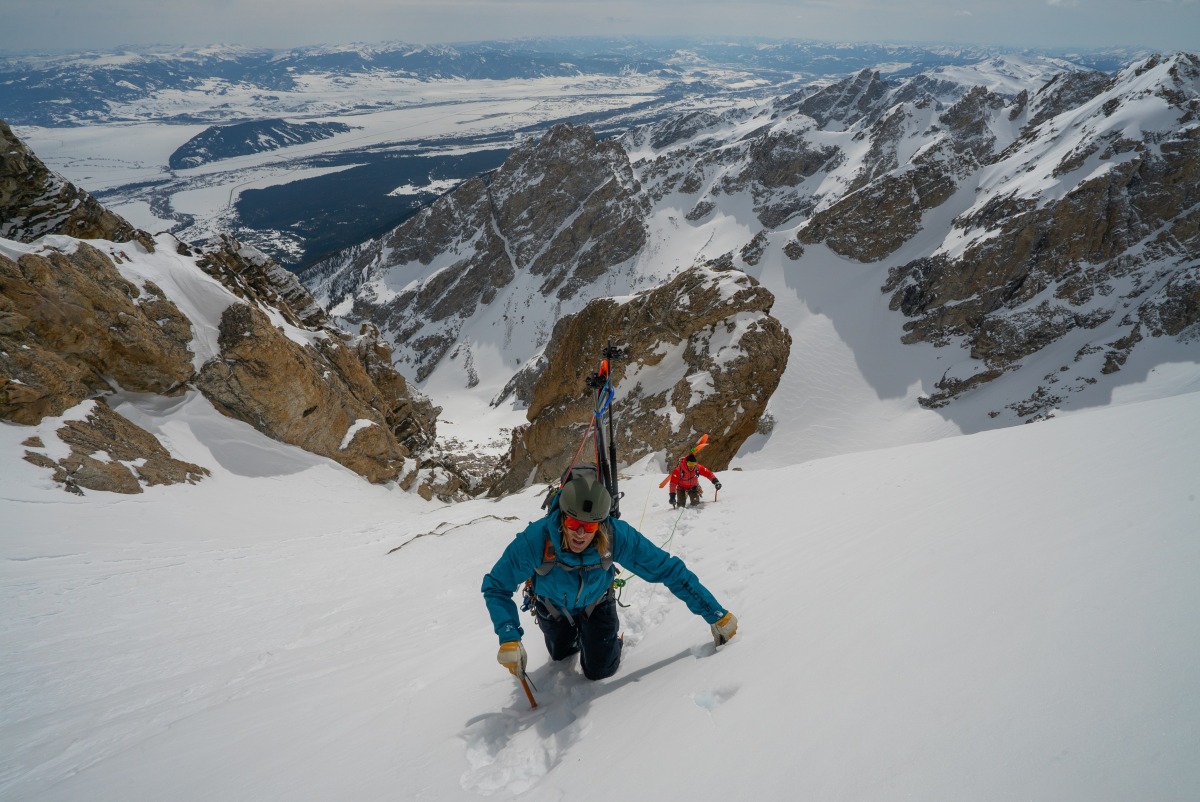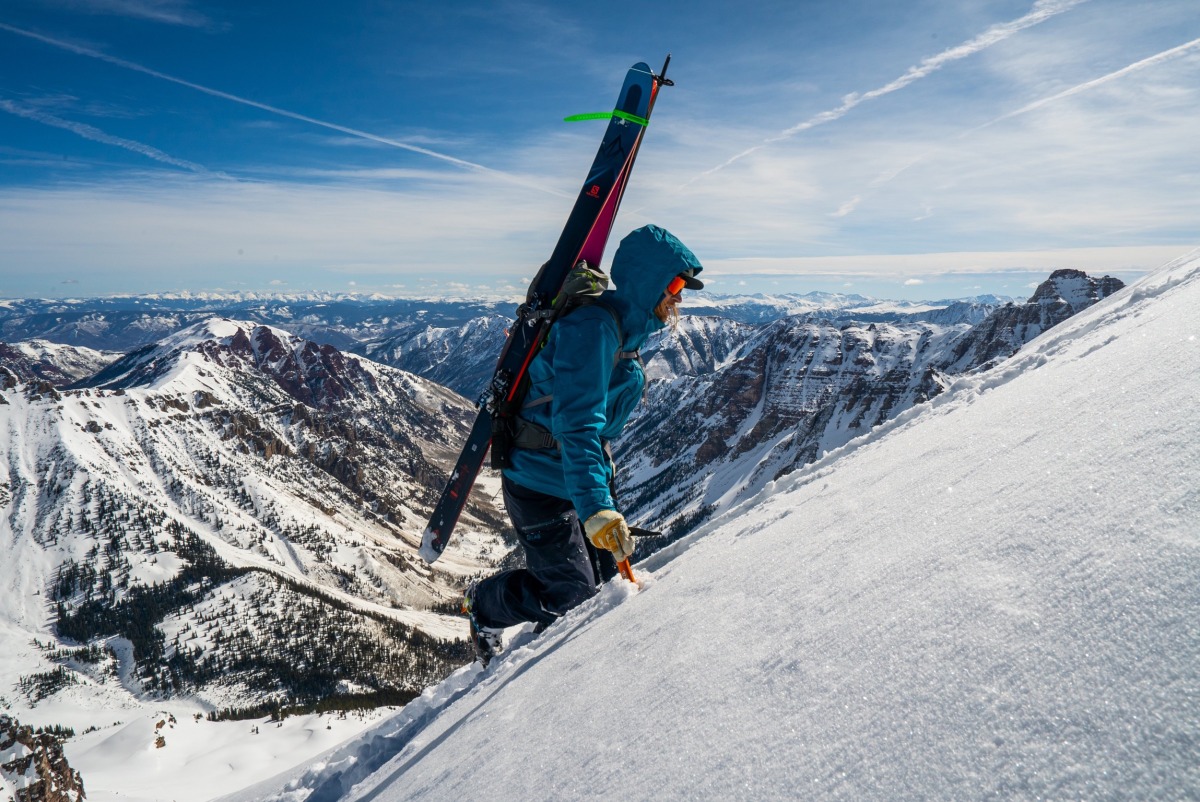
Cody Townsend and Jimmy Chin climbing the Grand Teton, Wyoming last season. Photo: Bjarne Salen @bjarnesalen
On Gear: Past , Present and Future
I caught up with Cody Townsend and chat about this season, skiing during the confusing corona times, and the future of “The Fifty Project”, published yesterday. We went on to ramble about gear as skiers do. Here are some loose-interview format takeaways for gear he’s on and what the Solomon team is working on.
GS: What was your first touring setup? Do you remember that dinosaur?
CT: Yes, I do. This hearkens back to my first time I skied Bloody Couloir. I was in Salomon plug boots. I had Alpine Trekkers, aka day wreckers. The 198 Salomon AK Rocket swallowtail skis, mounted with full-steel Salomon 916 bindings.
GS: Oh, that’s amazing. That’s like, 20 pounds of setup.
CT: At least. Now I look back and I’m like, “Yes, of course you hated touring back then.” It was the most exhausting, uncomfortable thing you could ever do. I literally despised touring for, maybe 10 years, until Salomon started making the stuff that you could tour in and not be uncomfortable, and not exhaust yourself at 100 vertical feet.

Townsend out of his element, in spandex, traversing on Killian Jornet’s powder skis. Photo: Bjarne Salen @bjarnesalen
GS: I watched the 50 Project boot mod episode recently. Are you taking over Killian Jornet’s place on the lightweight front for Salomon?
CT: No, God no. I skied on his X-ALP skis last year for the traverse episode. They are his fat skis and they were terrifying to me. I don’t know how he does it. I’m more of a gram counter than I’ve ever been, but there’s still a line. When it comes to some of the bigger expeditions like Saint Elias, yes, I’m going to go as light as works for me, something like MTN 95 skis and X-ALP boots, but the majority are on heavy boots and fat skis.
GS: There’s a place for classically trained skiers like yourself to get involved in the light gear development. What trends should we be looking forward to in that step up from race, mid-weight touring realm? Do you think that people like you are going to influence it?
CT: That’s where I and some of our team like Greg Hill and Chris Rubens are focused right now — the 1,000-1,500 gram boots that walk like a lightweight boot. I’ve tested pretty much every major boot in that class, and think there’s a lot of room for improvement across the board. The biggest innovation so far was Hoji’s walk mechanism that pushed everyone forward in that class. It’s interesting though because the boot that everyone loved in the ‘step up from race class’, the Alien RS, just got cancelled. So, the demand for it is low, which kind of sucks. I think that’s where the innovation is going to continue to happen, not necessarily in the 600 gram boots but in the 1,000-1,500 gram boot.
GS: I’m looking forward to that. I’ve skied lighter gear for a while, and feel like I prefer it now. I pulled out the Tecnica Zero G four buckle the other day for a tour, and felt like I couldn’t feel my ski or get into the sweet spot. Have your tastes evolved since you’ve been skiing light gear in bad snow?
CT: Yes, totally. Last year I was skiing on the X-ALP a bit, and then I went back to my MTN Lab and I was like, “God, these are so clunky-feeling.” For the first time in my life I’m factoring weight and efficiency into gear choices. My tastes have changed, but I also would say that this year I reverted a little bit. I went back to a heavier setup, and I’ve kind of enjoyed it more. I did more training, and so I’m stronger and able to pull it up a little bit easier.

Townsend climbing North Maroon peak in the WildSnow backyard. Mtn 95s, MTN bindings, and X-ALP boots were the choice that day. Photo: Bjarne Salen @bjarnesalen
GS: I noticed that you’re rocking the 118s and the bigger boot more this year.
CT: Pretty much all year. But, I’m also working with Salomon on the ski front. There’s a lot of potential innovation in that realm too. A lot of lightweight skis are just tinny, and they don’t ski that well, but I feel that with the right materials and shapes, we can get to a place where you have power and dampness out of a ski that’s in the 1,000, maybe 1,500 gram realm. Right now we’re seeing the performance around 2,000, and that’s really heavy for big days.
GS: What are some other things the development team is working on?
CT: Have you ever done a side-by-side comparison between a binding with toe unit elasticity and a binding without on the same ski? It is a massive how much worse ski skis with a binding with no toe elasticity. Really we kind of geek out, everyone’s like, power transfer and all that. Power transfer is nothing. It’s all about elasticity.
We did a test with the STH 2 alpine binding where we locked out one toe, and ran one with elasticity. One ski it would be carving on a groomer, and make the next turn, and you’d be chattering out. We realized, toe elasticity isn’t just for safety, it actually makes the ski perform better. It makes your turn better, it makes everything better. So, it’s kind of counter-intuitive, and it’s fun to learn through these processes of how your equipment interacts with your ski turn.
GS: That’s interesting, as we’re all running around on 80-gram toe pieces that actually ski worse, even though they’re more rigid and transfer more power.
CT: Yes. But we have learned about the interaction between the ski and the tech binding too. We will put the same binding on 5 different pairs of skis, and then vice versa, a bunch of different bindings on the same pair of skis, and you can see how the interaction between elasticity and torsional rigidity will influence the way the ski turns. So, in a ski that’s super lightweight and kind of floppy, that’s when having a little less elasticity can actually make it perform a little bit better. To me it’s a lot like surfing, the volume and the rail design and everything is interactive with each other, and if you have one of those things off. If you have hard rails on a board that is very high-performance, it just doesn’t work. The same goes with skiing, your binding interface and your boot interface has to match your ski, and vice versa. When I see a tech binding on a pair of on mountain skis on the resort I think, “Dude, what are you doing? You’re going to feel like shit all day and potentially Tib-Fib yourself.”
GS: I was in that boat for a couple of years on the resort. This season I screwed a Shift to a big ski and remembered what alpine gear was all about.
CT: Yes. You kind of realize, “Okay, that makes sense.” So, yes, I think we’re all trying to work toward the Holy Grail, the lightest setup that is safe and skis well, that we all want to ski.
Subscribe to the Fifty Project webisodes and revisit Cody Townsend Quarantine Q&A Part I here.
On March 22nd 2021, Gary Smith tragically died in an avalanche outside of Beaver Creek Resort in Colorado. Since 2018, Gary has been a frequent and insightful contributor to WildSnow. From Christmas Eve spent at the Wildsnow Field HQ cabin, to testing gear and sharing his love for steep skiing around the world, he was a pillar of the ski touring community and will be greatly missed.
